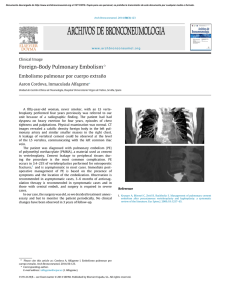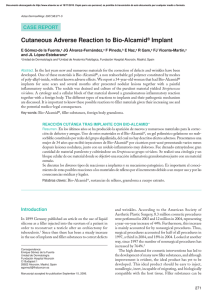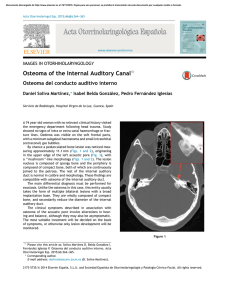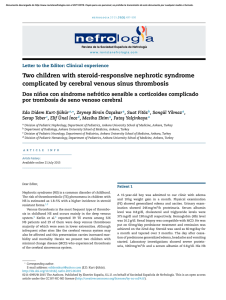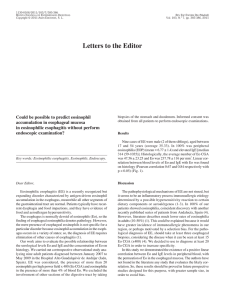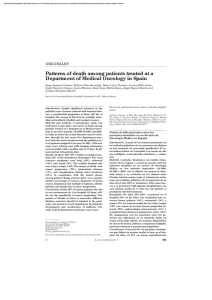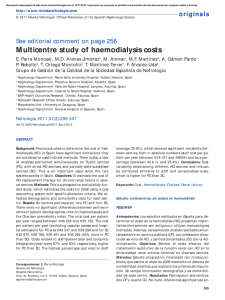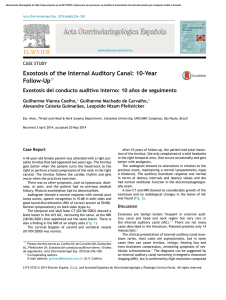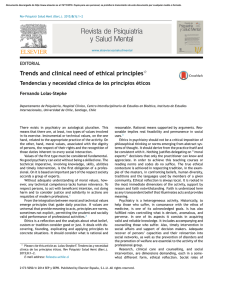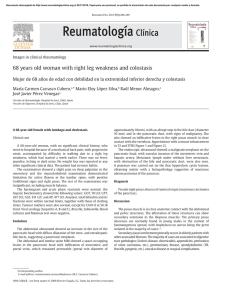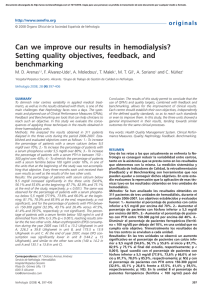Adverse anaphilactoid reaction of oxaloplatin
Anuncio
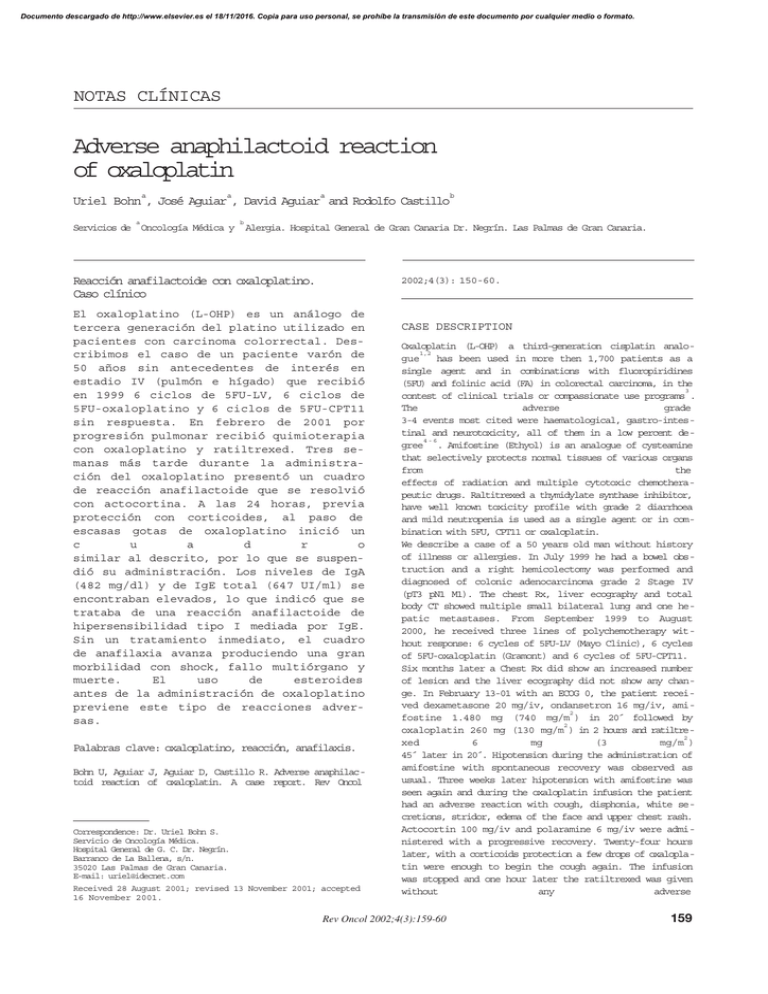
Documento descargado de http://www.elsevier.es el 18/11/2016. Copia para uso personal, se prohíbe la transmisión de este documento por cualquier medio o formato. NOTAS CLÍNICAS Adverse anaphilactoid reaction of oxaloplatin a a a b Uriel Bohn , José Aguiar , David Aguiar and Rodolfo Castillo a Servicios de Oncología Médica y b Alergia. Hospital General de Gran Canaria Dr. Negrín. Las Palmas de Gran Canaria. Reacción anafilactoide con oxaloplatino. Caso clínico 2002;4(3): 150-60. El oxaloplatino (L-OHP) es un análogo de tercera generación del platino utilizado en pacientes con carcinoma colorrectal. Describimos el caso de un paciente varón de 50 años sin antecedentes de interés en estadio IV (pulmón e hígado) que recibió en 1999 6 ciclos de 5FU-LV, 6 ciclos de 5FU-oxaloplatino y 6 ciclos de 5FU-CPT11 sin respuesta. En febrero de 2001 por progresión pulmonar recibió quimioterapia con oxaloplatino y ratiltrexed. Tres semanas más tarde durante la administración del oxaloplatino presentó un cuadro de reacción anafilactoide que se resolvió con actocortina. A las 24 horas, previa protección con corticoides, al paso de escasas gotas de oxaloplatino inició un c u a d r o similar al descrito, por lo que se suspendió su administración. Los niveles de IgA (482 mg/dl) y de IgE total (647 UI/ml) se encontraban elevados, lo que indicó que se trataba de una reacción anafilactoide de hipersensibilidad tipo I mediada por IgE. Sin un tratamiento inmediato, el cuadro de anafilaxia avanza produciendo una gran morbilidad con shock, fallo multiórgano y muerte. El uso de esteroides antes de la administración de oxaloplatino previene este tipo de reacciones adversas. Palabras clave: oxaloplatino, reacción, anafilaxis. Bohn U, Aguiar J, Aguiar D, Castillo R. Adverse anaphilactoid reaction of oxaloplatin. A case report. Rev Oncol Correspondence: Dr. Uriel Bohn S. Servicio de Oncología Médica. Hospital General de G. C. Dr. Negrín. Barranco de La Ballena, s/n. 35020 Las Palmas de Gran Canaria. E-mail: [email protected] Received 28 August 2001; revised 13 November 2001; accepted 16 November 2001. CASE DESCRIPTION Oxaloplatin (L-OHP) a third-generation cisplatin analo1,2 gue has been used in more then 1,700 patients as a single agent and in combinations with fluoropiridines (5FU) and folinic acid (FA) in colorectal carcinoma, in the 3 contest of clinical trials or compassionate use programs . The adverse grade 3-4 events most cited were haematological, gastro-intestinal and neurotoxicity, all of them in a low percent de4-6 gree . Amifostine (Ethyol) is an analogue of cysteamine that selectively protects normal tissues of various organs from the effects of radiation and multiple cytotoxic chemotherapeutic drugs. Raltitrexed a thymidylate synthase inhibitor, have well known toxicity profile with grade 2 diarrhoea and mild neutropenia is used as a single agent or in combination with 5FU, CPT11 or oxaloplatin. We describe a case of a 50 years old man without history of illness or allergies. In July 1999 he had a bowel obstruction and a right hemicolectomy was performed and diagnosed of colonic adenocarcinoma grade 2 Stage IV (pT3 pN1 M1). The chest Rx, liver ecography and total body CT showed multiple small bilateral lung and one hepatic metastases. From September 1999 to August 2000, he received three lines of polychemotherapy without response: 6 cycles of 5FU-LV (Mayo Clinic), 6 cycles of 5FU-oxaloplatin (Gramont) and 6 cycles of 5FU-CPT11. Six months later a Chest Rx did show an increased number of lesion and the liver ecography did not show any change. In February 13-01 with an ECOG 0, the patient received dexametasone 20 mg/iv, ondansetron 16 mg/iv, ami2 fostine 1.480 mg (740 mg/m ) in 20´ followed by 2 oxaloplatin 260 mg (130 mg/m ) in 2 hours and ratiltre2 xed 6 mg (3 mg/m ) 45´ later in 20´. Hipotension during the administration of amifostine with spontaneous recovery was observed as usual. Three weeks later hipotension with amifostine was seen again and during the oxaloplatin infusion the patient had an adverse reaction with cough, disphonia, white secretions, stridor, edema of the face and upper chest rash. Actocortin 100 mg/iv and polaramine 6 mg/iv were administered with a progressive recovery. Twenty-four hours later, with a corticoids protection a few drops of oxaloplatin were enough to begin the cough again. The infusion was stopped and one hour later the ratiltrexed was given without any adverse Rev Oncol 2002;4(3):159-60 159 Documento descargado de http://www.elsevier.es el 18/11/2016. Copia para uso personal, se prohíbe la transmisión de este documento por cualquier medio o formato. BOHN U, AGUIAR J, AGUIAR D, ET AL. ADVERSE ANAPHILACTOID REACTION OF OXALOPLATIN. A CASE REPORT effect. 3 The blood test showed: leukocytes: 9.1 × 1 0 /ul. Neu3 trophi-les 69.9%. Lymphocites: 1.6 × 1 0 /uL. Eosinophiles: 0.4 × 3 3 1 0 /ul. Hb: 12.5 Gr. Platelets: 372 × 1 0 /ul. GGT: 69 U/l. LDH: 878 U/l. Fe: 25 mg/dl. IgG: 1,430 mg/dl. IgA: 482 mg/dl. IgM: 224 mg/dl. Total IgE: 647 UI/ml (14-120 UI/ml). The value of IgA was elevated and the total IgE was very high. 7 There have been reported one anaphylactic case and one 8 idiosyncratic reaction with the use of oxaloplatin . In our case the chronology of issues seems to be related with an anafilactoid reaction type I immune hypersensitivity reaction mediated by IgE, which induces mast-cell activation. The reaction is produced by an escalating release of mediators from mast cells and basophils. Mast cell and basophil activation is most usually initiated when specific antigen binds to and cross-links preattached surface IgE molecules. The sequence of events in immediate hypersensitivity stars with production of ice by B-cells in response to the first exposure to an antigen; binding of the IgE to specific Fc receptors on the surfaces of masts cells and basophils, and interaction of re-introduced antigen with the bound IgE, leading to activation of the mast cells and basophils. 160 IgE and eosinophil-mediated immune reactions are dependent on the activation of CD-4 helper and T-cells of the T H 2 subset. The cytokines produced by TH 2 cells are responsible for inmediated type hypersensitivity. Without an immediate treatment, anaphylaxis goes along with great morbidity (shock, multiple organ failure) and 9 mortality . However, the steroid protocol must be administered before oxaloplatin is given in order to prevent adverse effects. Key words: oxaloplatin, reaction, anaphilaxis. References 1. O´Dwyer PJ, Johnson SW, Hamilton TC. Cisplatin and its analogues. In: DeVita VT Jr, Hellman S, Rosenberg SA, editors. Cancer principles & practice of oncology. 5th ed. Philadelphia: Lippincott- Raven; 1997. p. 41832 2. Rixe O, Ortura W, Alvarez M, et al. Oxaloplatin, tetraplatin, cisplatin and carboplatin: spectrum of activity in drug-resistant cell lines and in the cell lines of the National Cancer Institute´s Anticancer Drug Screen panel. Biochem Pharmacol 1996;52:1855-65. 3. Mathe G, Kidany Y, Triana K, et al. A phase I trial of Trans-I-diaminocyclohexane oxalato-platinum. Biomed Pharmacother 1986;40:372-6. Rev Oncol 2002;4(3):159-60 Documento descargado de http://www.elsevier.es el 18/11/2016. Copia para uso personal, se prohíbe la transmisión de este documento por cualquier medio o formato. NOAH C. CHOI ET AL.— RECENT PROGRESS IN OPTIMIZING RADIOTHERAPY IN CHEMORADIOTHERAPY FOR STAGE III NON-SMALL CELL LUNG CANCER 4. Extra JM, Espie M, Calvo F, et al. Phase I study of oxaloplatin in patients with advanced cancer. Cancer Pharmacother 1990;25:299-303. 5. Mitchell EP, Lo Russo P, Giococo K, et al. Safely profile of oxaloplatin (single agent or with 5-FU) from the large North American comjpassionate use experience in advanced colorectal cancer. Pro Am Soc Clin Oncol 2000 (Abstrat 1259). 6. Medioni J, Coulon MA, Morete JF, et al. Anaphilaxis after oxaloplatin. Onn Oncol 1999;10:610. 7. Santini D, Tonini A, Salerno A, et al. Idiosyncratic reaction after oxaloplatin infusion. Ann Oncology 2001; 12:131-3. 8. Immunoglobulin E - Initiated immune reactions in (eds) 199. p. 298-312. 9. Muller-Werdam U, Werdam K. Wien Klin Wochenschr 2000;112(4):149-56. 3
